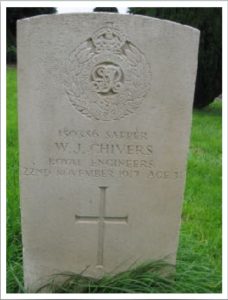26th Light Railway Section, Royal Engineers

William Josiah Chivers was born in July 1886 at Rainbow Hill, Worcester.
He was the son of Henry Thomas Chivers and his wife Elizabeth (née Pulman), who had married in February 1882 and had five children. The eldest child was Ada (born 1883) followed by Cecil Henry John (1885), William, Julia Alice Clara (1888) and Wallace Alfred Thomas (1890: died 1896).
By the time of the 1911 census the family was living at 87 St Paul’s Road, Gloucester. Henry Chivers (an engineers’ storekeeper) died in June 1913, aged 57: his wife died in 1934, aged 74. The census showed William to be an agent for automachines.
Unusually both an Army Service Record and Pension Record have survived for William Chivers at the National Archives. He attested for military service (for the duration of the war) on 2 December 1915, probably through ‘Lord Derby’s Scheme’, which was the precursor to full compulsory conscription. He gave his age as 29 years, five months and his occupation as a ‘collector’: he noted that he was a single man and that his mother was his next of kin. Interestingly his attestation papers record he was introduced by ‘J Pollard, Paid Recruiter’.
He was initially placed into the Army Reserve, pending mobilisation, which occurred on 22 February 1916 and he was posted to the Royal Engineers (Railway Operating Division). On 23 January 1917 he obtained a trade qualification as a ‘moulder’, before going to join the British
Expeditionary Force in France on 12 March 1917, as part of No 26 Light Railway Section.
There was an extensive network of light railways behind and up to the front lines, which principally facilitated the transport of ammunition and materials. Building and maintaining these would be a full time occupation.
Within a month of arriving in France, on 3 April 1917, William was admitted to the No 10 Stationery Hospital at St Omer, where he stayed until 18 April and was then sent to England and the Royal Herbert Hospital at Woolwich.
On 31 May 1917 he was examined by an Army medical board who confirmed a diagnosis of ‘chronic intestinal nephritis’ or kidney disease. The board considered him ‘quite unfit for any military service, in spite of the appearance he might present to a casual glance’. It considered that the condition was aggravated by active service and granted him a full disability pension for six months. On 26 June 1917 he was discharged from the Army as no longer physically fit for war service and he was granted a Silver War Badge to denote discharge following service.
It is presumed that he went back to his home in Gloucester where his conditioned worsened.
A report of his funeral in the Gloucestershire Journal of 1 December 1917 notes that he had been invalided home from France with Bright’s Disease (also known as nephritis) and had latterly been in the Red Cross Hospital, Great Western Road, Gloucester for one month before he died on 22 November 1917, aged 31. The report noted that he had been employed by the Monarch
Automatic Machine Co of Northampton, prior to Army service.
His funeral took place with military honours at St Luke’s Church, Gloucester on 26 November. He was buried in Gloucester Old Cemetery, where a standard CWGC headstone marks his grave. He is remembered on the Gloucester War Memorial.
Researched by Graham Adams 10 November 2018
